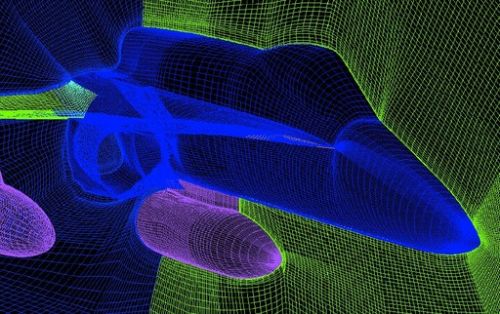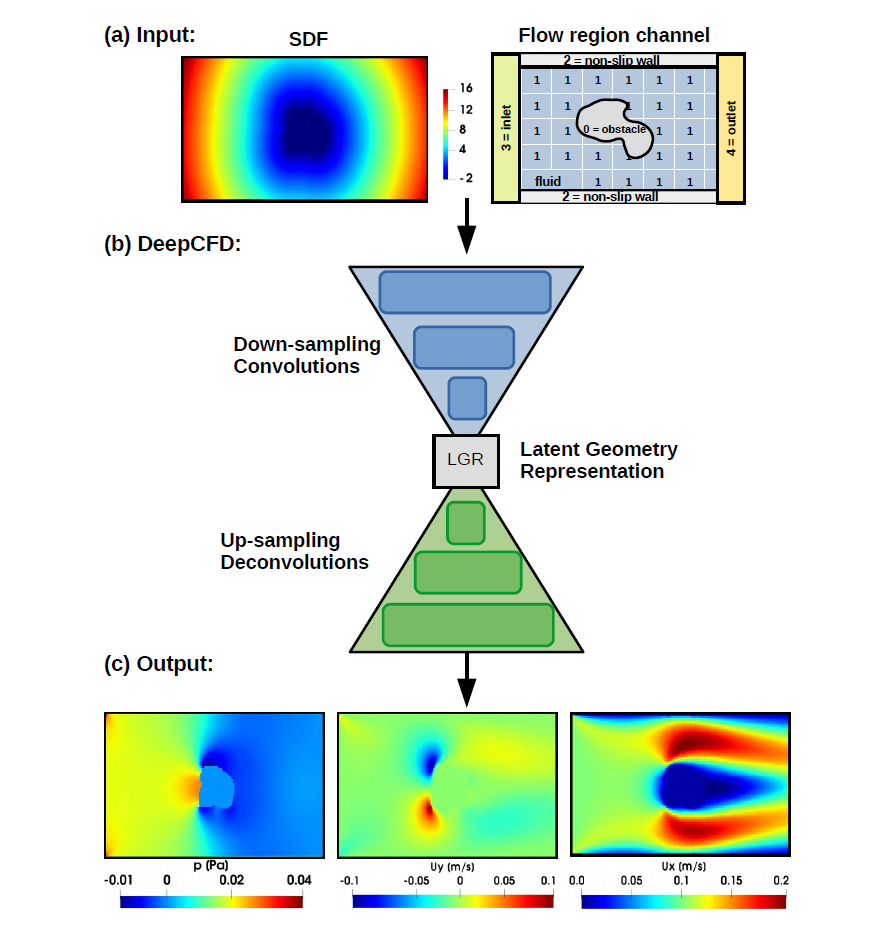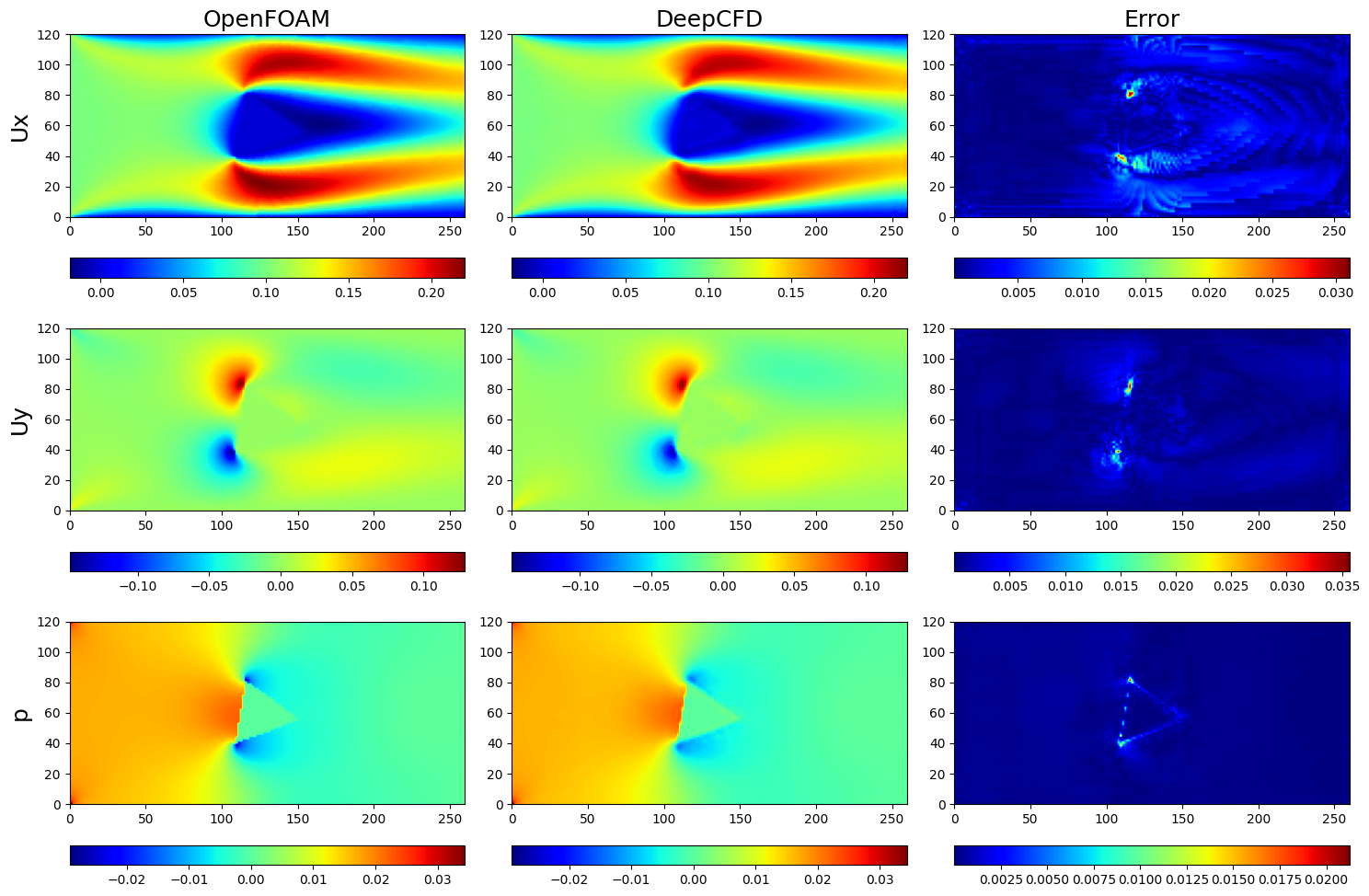DeepCFD(Deep Computational Fluid Dynamics)¶
# linux
wget -nc -P ./datasets/ https://paddle-org.bj.bcebos.com/paddlescience/datasets/DeepCFD/dataX.pkl
wget -nc -P ./datasets/ https://paddle-org.bj.bcebos.com/paddlescience/datasets/DeepCFD/dataY.pkl
# windows
# curl --create-dirs -o ./datasets/dataX.pkl https://paddle-org.bj.bcebos.com/paddlescience/datasets/DeepCFD/dataX.pkl
# curl --create-dirs -o ./datasets/dataX.pkl https://paddle-org.bj.bcebos.com/paddlescience/datasets/DeepCFD/dataY.pkl
python deepcfd.py
# linux
wget -nc -P ./datasets/ https://paddle-org.bj.bcebos.com/paddlescience/datasets/DeepCFD/dataX.pkl
wget -nc -P ./datasets/ https://paddle-org.bj.bcebos.com/paddlescience/datasets/DeepCFD/dataY.pkl
# windows
# curl --create-dirs -o ./datasets/dataX.pkl https://paddle-org.bj.bcebos.com/paddlescience/datasets/DeepCFD/dataX.pkl
# curl --create-dirs -o ./datasets/dataX.pkl https://paddle-org.bj.bcebos.com/paddlescience/datasets/DeepCFD/dataY.pkl
python deepcfd.py mode=eval EVAL.pretrained_model_path=https://paddle-org.bj.bcebos.com/paddlescience/models/deepcfd/deepcfd_pretrained.pdparams
| 预训练模型 | 指标 |
|---|---|
| deepcfd_pretrained.pdparams | MSE.Total_MSE(mse_validator): 1.92947 MSE.Ux_MSE(mse_validator): 0.70684 MSE.Uy_MSE(mse_validator): 0.21337 MSE.p_MSE(mse_validator): 1.00926 |
1. 背景简介¶
计算流体力学(Computational fluid dynamics, CFD)模拟通过求解 Navier-Stokes 方程(N-S 方程),可以获得流体的各种物理量的分布,如密度、压力和速度等。在微电子系统、土木工程和航空航天等领域应用广泛。
在某些复杂的应用场景中,如机翼优化和流体与结构相互作用方面,需要使用千万级甚至上亿的网格对问题进行建模(如下图所示,下图展示了 F-18 战斗机的全机内外流一体结构化网格模型),导致 CFD 的计算量非常巨大。因此,目前亟需发展出一种相比于传统 CFD 方法更高效,且可以保持计算精度的方法。
2. 问题定义¶
Navier-Stokes 方程是用于描述流体运动的方程,它的二维形式如下,
质量守恒:
动量守恒:
其中 \(\bf{u}\) 是速度场(具有 x 和 y 两个维度),\(\rho\) 是密度, \(p\) 是压强场,\(\bf{f}\) 是体积力(例如重力)。
假设满足非均匀稳态流体条件,方程可去掉时间相关项,并将 \(\bf{u}\) 分解为速度分量 \(u_x\) 和 \(u_y\) ,动量方程可重写成:
其中 \(g\) 代表重力加速度,\(\nu\) 代表流体的动力粘度。
3. 问题求解¶
上述问题通常可使用 OpenFOAM 进行传统数值方法的求解,但计算量很大,接下来开始讲解如何基于 PaddleScience 代码,用深度学习的方法求解该问题。
本案例基于论文 Ribeiro M D, Rehman A, Ahmed S, et al. DeepCFD: Efficient steady-state laminar flow approximation with deep convolutional neural networks 的方法进行求解,关于该方法的理论部分请参考原论文。 为了快速理解 PaddleScience,接下来仅对模型构建、方程构建、计算域构建等关键步骤进行阐述,而其余细节请参考 API文档。
3.1 数据集介绍¶
该数据集中的数据使用 OpenFOAM 求得。数据集有两个文件 dataX 和 dataY。dataX 包含 981 个通道流样本几何形状的输入信息,dataY 包含对应的 OpenFOAM 求解结果。
运行本问题代码前请按照下方命令下载 dataX 和 dataY:
wget -nc -P ./datasets/ https://paddle-org.bj.bcebos.com/paddlescience/datasets/DeepCFD/dataX.pkl
wget -nc -P ./datasets/ https://paddle-org.bj.bcebos.com/paddlescience/datasets/DeepCFD/dataY.pkl
dataX 和 dataY 都具有相同的维度(Ns,Nc,Nx,Ny),其中第一轴是样本数(Ns),第二轴是通道数(Nc),第三和第四轴分别是 x 和 y 中的元素数量(Nx 和 Ny)。在输入数据 dataX 中,第一通道是计算域中障碍物的SDF(Signed distance function),第二通道是流动区域的标签,第三通道是计算域边界的 SDF。在输出数据 dataY 中,第一个通道是水平速度分量(Ux),第二个通道是垂直速度分量(Uy),第三个通道是流体压强(p)。
数据集原始下载地址为:https://zenodo.org/record/3666056/files/DeepCFD.zip?download=1
我们将数据集以 7:3 的比例划分为训练集和验证集,代码如下:
3.2 模型构建¶
在上述问题中,我们确定了输入为 input,输出为 output,按照论文所述,我们使用含有 3 个 encoder 和 decoder 的 UNetEx 网络来创建模型。
模型的输入包含了障碍物的 SDF(Signed distance function)、流动区域的标签以及计算域边界的 SDF。模型的输出包含了水平速度分量(Ux),垂直速度分量(Uy)以及流体压强(p)。
模型创建用 PaddleScience 代码表示如下:
3.3 约束构建¶
本案例基于数据驱动的方法求解问题,因此需要使用 PaddleScience 内置的 SupervisedConstraint 构建监督约束。在定义约束之前,需要首先指定监督约束中用于数据加载的各个参数,代码如下:
SupervisedConstraint 的第一个参数是数据的加载方式,这里填入相关数据的变量名。
第二个参数是损失函数的定义,这里使用自定义的损失函数,分别计算 Ux 和 Uy 的均方误差,以及 p 的标准差,然后三者加权求和。
第三个参数是约束条件的名字,方便后续对其索引。此次命名为 "sup_constraint"。
在监督约束构建完毕之后,以我们刚才的命名为关键字,封装到一个字典中,方便后续访问。
| examples/deepcfd/deepcfd.py | |
|---|---|
3.4 超参数设定¶
接下来需要在配置文件中指定训练轮数,此处我们按实验经验,使用一千轮训练轮数。
| examples/deepcfd/conf/deepcfd.yaml | |
|---|---|
3.5 优化器构建¶
训练过程会调用优化器来更新模型参数,此处选择较为常用的 Adam 优化器,学习率设置为 0.001,权重衰减设置为 0.005。
| examples/deepcfd/deepcfd.py | |
|---|---|
3.6 评估器构建¶
在训练过程中通常会按一定轮数间隔,用验证集评估当前模型的训练情况,我们使用 ppsci.validate.SupervisedValidator 构建评估器。
评价指标 metric 这里自定义了四个指标 Total_MSE、Ux_MSE、Uy_MSE 和 p_MSE。
其余配置与 约束构建 的设置类似。
3.7 模型训练、评估¶
完成上述设置之后,只需要将上述实例化的对象按顺序传递给 ppsci.solver.Solver,然后启动训练、评估。
3.8 结果可视化¶
使用 matplotlib 绘制相同输入参数时的 OpenFOAM 和 DeepCFD 的计算结果,进行对比。这里绘制了验证集第 0 个数据的计算结果。
| examples/deepcfd/deepcfd.py | |
|---|---|
4. 完整代码¶
| examples/deepcfd/deepcfd.py | |
|---|---|
1 2 3 4 5 6 7 8 9 10 11 12 13 14 15 16 17 18 19 20 21 22 23 24 25 26 27 28 29 30 31 32 33 34 35 36 37 38 39 40 41 42 43 44 45 46 47 48 49 50 51 52 53 54 55 56 57 58 59 60 61 62 63 64 65 66 67 68 69 70 71 72 73 74 75 76 77 78 79 80 81 82 83 84 85 86 87 88 89 90 91 92 93 94 95 96 97 98 99 100 101 102 103 104 105 106 107 108 109 110 111 112 113 114 115 116 117 118 119 120 121 122 123 124 125 126 127 128 129 130 131 132 133 134 135 136 137 138 139 140 141 142 143 144 145 146 147 148 149 150 151 152 153 154 155 156 157 158 159 160 161 162 163 164 165 166 167 168 169 170 171 172 173 174 175 176 177 178 179 180 181 182 183 184 185 186 187 188 189 190 191 192 193 194 195 196 197 198 199 200 201 202 203 204 205 206 207 208 209 210 211 212 213 214 215 216 217 218 219 220 221 222 223 224 225 226 227 228 229 230 231 232 233 234 235 236 237 238 239 240 241 242 243 244 245 246 247 248 249 250 251 252 253 254 255 256 257 258 259 260 261 262 263 264 265 266 267 268 269 270 271 272 273 274 275 276 277 278 279 280 281 282 283 284 285 286 287 288 289 290 291 292 293 294 295 296 297 298 299 300 301 302 303 304 305 306 307 308 309 310 311 312 313 314 315 316 317 318 319 320 321 322 323 324 325 326 327 328 329 330 331 332 333 334 335 336 337 338 339 340 341 342 343 344 345 346 347 348 349 350 351 352 353 354 355 356 357 358 359 360 361 362 363 364 365 366 367 368 369 370 371 372 373 374 375 376 377 378 379 380 381 382 383 384 385 386 387 388 389 390 391 392 393 394 395 396 397 398 399 400 401 402 403 404 405 406 407 408 409 410 411 412 413 414 415 416 417 418 419 420 421 422 423 424 425 426 427 428 429 430 431 432 433 434 435 436 437 438 439 440 441 442 443 444 445 446 447 448 449 450 451 452 453 454 455 456 457 458 459 460 461 462 463 464 | |
5. 结果展示¶
可以看到DeepCFD方法与OpenFOAM的结果基本一致。


